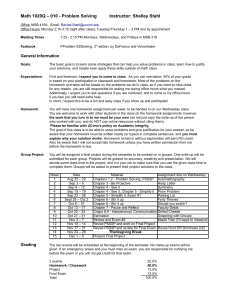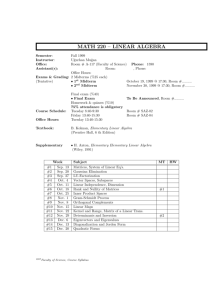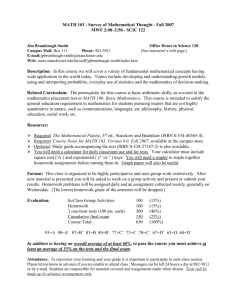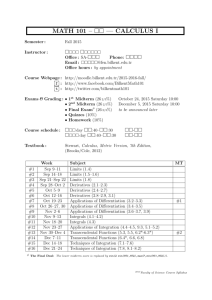AE 467
advertisement
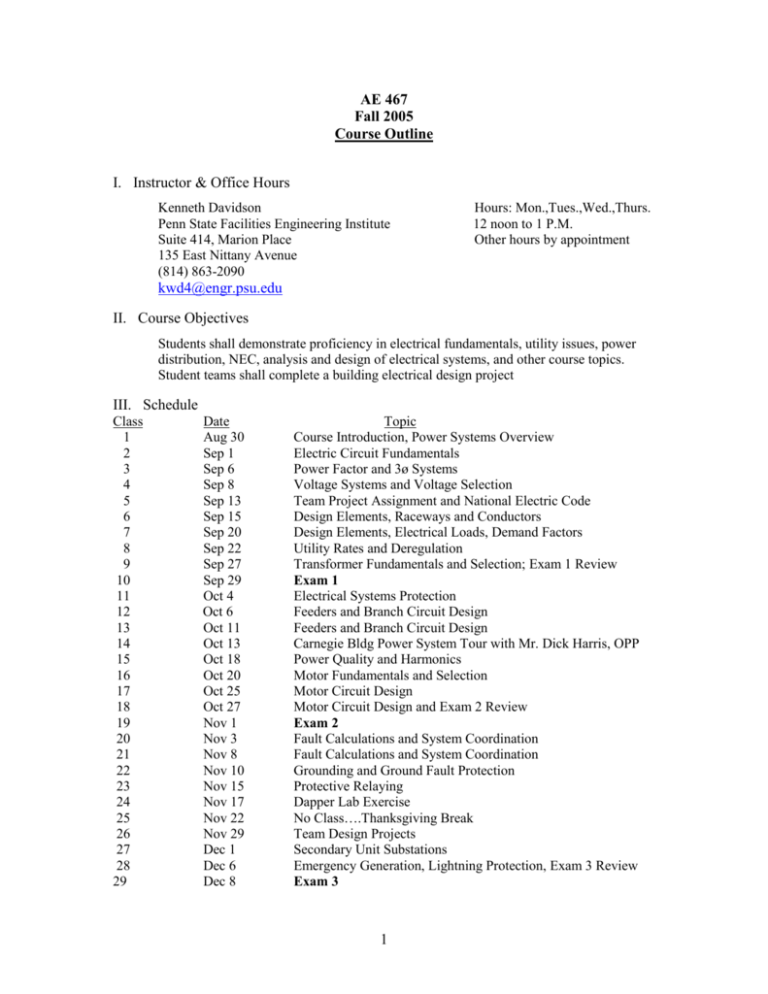
AE 467 Fall 2005 Course Outline I. Instructor & Office Hours Kenneth Davidson Penn State Facilities Engineering Institute Suite 414, Marion Place 135 East Nittany Avenue (814) 863-2090 Hours: Mon.,Tues.,Wed.,Thurs. 12 noon to 1 P.M. Other hours by appointment kwd4@engr.psu.edu II. Course Objectives Students shall demonstrate proficiency in electrical fundamentals, utility issues, power distribution, NEC, analysis and design of electrical systems, and other course topics. Student teams shall complete a building electrical design project III. Schedule Class 1 2 3 4 5 6 7 8 9 10 11 12 13 14 15 16 17 18 19 20 21 22 23 24 25 26 27 28 29 Date Aug 30 Sep 1 Sep 6 Sep 8 Sep 13 Sep 15 Sep 20 Sep 22 Sep 27 Sep 29 Oct 4 Oct 6 Oct 11 Oct 13 Oct 18 Oct 20 Oct 25 Oct 27 Nov 1 Nov 3 Nov 8 Nov 10 Nov 15 Nov 17 Nov 22 Nov 29 Dec 1 Dec 6 Dec 8 Topic Course Introduction, Power Systems Overview Electric Circuit Fundamentals Power Factor and 3ø Systems Voltage Systems and Voltage Selection Team Project Assignment and National Electric Code Design Elements, Raceways and Conductors Design Elements, Electrical Loads, Demand Factors Utility Rates and Deregulation Transformer Fundamentals and Selection; Exam 1 Review Exam 1 Electrical Systems Protection Feeders and Branch Circuit Design Feeders and Branch Circuit Design Carnegie Bldg Power System Tour with Mr. Dick Harris, OPP Power Quality and Harmonics Motor Fundamentals and Selection Motor Circuit Design Motor Circuit Design and Exam 2 Review Exam 2 Fault Calculations and System Coordination Fault Calculations and System Coordination Grounding and Ground Fault Protection Protective Relaying Dapper Lab Exercise No Class….Thanksgiving Break Team Design Projects Secondary Unit Substations Emergency Generation, Lightning Protection, Exam 3 Review Exam 3 1 IV. Course Overview Calculate current, voltage, impedance, and power for 1φ and 3φ networks. Understand various voltage systems and be able to select the proper electrical distribution system configuration for a facility. Calculate power factor, load factor, and power factor correction. Determine electrical loads and apply demand factors for sizing of components. Determine proper size for switchgear, transformers, protective devices, branch circuits, feeders, and panelboards. Properly select and size conductors, conduit, and grounding with respect to electrical load, voltage drop, ambient temperature, temperature restrictions on connections, and available short circuit current. Select and size switches, motor starters, and overcurrent protection for motor branch circuits and motor control centers. Understand and compute short circuit currents using ohmic and per-unit methods. Understand concepts and types of emergency generation systems and automatic transfer switches. Understand the importance of power quality and the effects of harmonics on building electrical systems. Understand basic concepts and computations of electric deregulation and utility rates. Understand uninterruptible power supplies, motor generator sets, and lightning protection. Understand protective device time-current curves and perform coordination studies for protective devices. Understand grounding systems and ground fault protection. Understand and properly apply the National Electrical Code in design and device selection. Apply the course concepts in a student team effort to design a complete electrical system for an industrial or commercial building. V. Course Work and Grading Course work will consist of text and National Electric Code readings and homework. Readings and homework will be assigned in class. Homework assignments not submitted on the due date will receive grade of 0. However, exceptions will be made for illness, emergencies, field trips and other circumstances beyond a student’s control. The course will include three exams and a team design project. Students will be assigned to a team to complete an electrical design project due at 3 p.m. on December 7, 2005. Class attendance is highly encouraged. Students who miss classes may have difficulty catching up because of the sheer volume of subject matter and work requirements. Grades will be assigned as follows: A (90-100%), B (80-89%), C (70-79%) D (60-69%), F (< 60%). Final grades will be computed as follows with the low grade dropped on one of the exams: Grade Distribution Homework Exam 1 Exam 2 Exam 3 Project 10% 30% 30% 30% 30% 2 VI. Texts (1) Electrical Systems in Buildings, Hughes, David S., Delmar Publications, ISBN 0-8273-3876-7 (2) 2005 National Electric Code, National Fire Protection Association VII. Academic Integrity Academic integrity is the pursuit of scholarly activity in an open, honest, and responsible climate and is the basis for all academic activity at Penn State. Academic integrity demands a commitment by all not to engage in or tolerate acts of falsification, misrepresentation, or deception. All students’ careers as professionals will require high ethical conduct and professional courtesy. In AE 467, we will adhere to the policy set forth by the College of Engineering on academic matters which are covered in the Academic Integrity Committee’s Policy and Procedure booklet and can be found at this site: www.engr.psu.edu/ug/acad_int/docs/policies.pdf . AE 467 Fall 2005 Tue & Thur, 8am-9:15 am 108 Sackett 3

